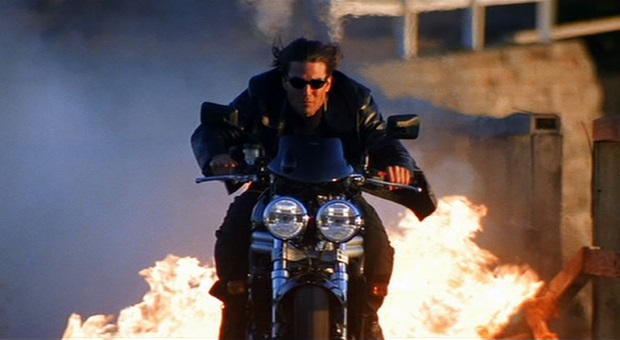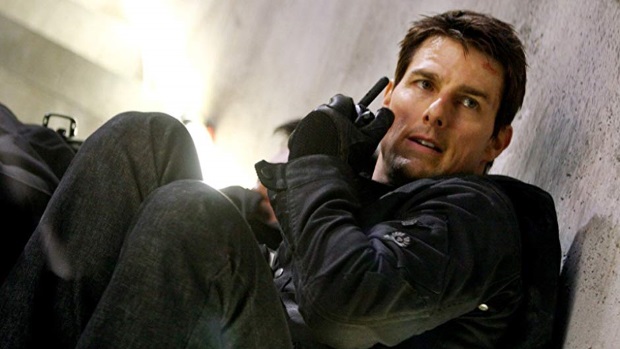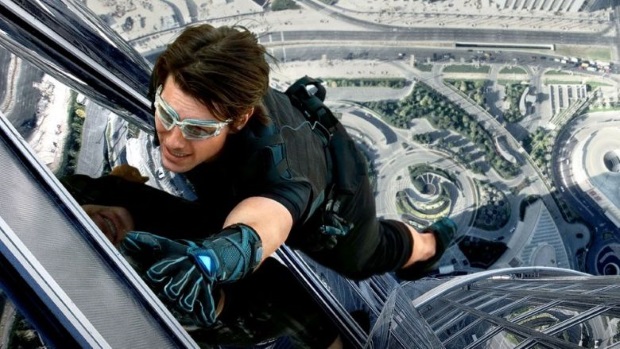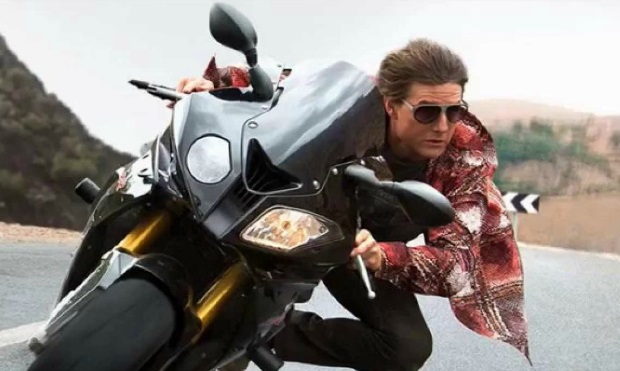The Behind-the-Scenes Battles of the Mission: Impossible Franchise
The stunts are hairy, but there's been drama behind the scenes, too. We look at the private battles of the Mission: Impossible movies..
This article comes from Den of Geek UK.
The Mission: Impossible franchise is one of the most eclectic and hard-wearing franchises in cinematic history. Centered mostly around the increasingly awesome exploits of Tom Cruise as Impossible Mission Force agent Ethan Hunt, it’s a series of six movies by five different directors, released over 22 years.
They’ve never looked like particularly easy movies to make, but in more than two decades on screen, the series has faced some major uphill struggles. From the 1996 film that lit the fuse (and blew up the rules of the 1960s TV series it was based on in the process) to the dizzying culmination of the currently-playing sixth instalment, Fallout, there have been battles behind the scenes.
Read the latest Den of Geek Special Edition Magazine Here!
Because of the way the online news cycle works now, we get to hear about a lot of this stuff before the film comes out. Fallout only hit cinemas last week, but we’ve been hearing for months about how production was shut down because Cruise broke his ankle performing a stunt in London and, of course, how Superman got his CG shave in Justice League because Henry Cavill had already moved onto filming this film.
With some distance from previous instalments, it’s no shock to find out that they had some issues on their way to our screens. With McQuarrie as the only director in the franchise’s history to return for a second Mission, the rest of the franchise is bound in part by changing trends in blockbuster cinema and the various phases of Cruise’s mega-stardom.
While other multi-director franchises, such as Marvel, Harry Potter, and James Bond, could be described as producer-driven, Mission: Impossible is unique insofar as the producer is also the star, and he was instrumental in starting the film franchise from the very beginning.
Mission: Impossible (1996)

“My team is dead!”
Back in 1993, Cruise formed Cruise/Wagner Productions with casting agent-turned-producer Paula Wagner. While looking for their first project, Cruise learned that Paramount was looking to relaunch Mission: Impossible as a film series. As a fan of the TV show when he was younger, he was eager for his company to spearhead the project and asked the studio for a $70 million budget.
Paramount executives reportedly wanted to keep the film in the $40-50 million range, but as production went on, the final figure wound up much closer to Cruise’s desired budget. Still, it took a lot of development to get to that point, as more action sequences added during production.
Director Sydney Pollack was attached early on, but Brian De Palma took the helm on the film proper, having previous, Oscar-nominated form in re-imagining old TV series for the big screen with 1987’s The Untouchables. From the cinematography to the unpredictable espionage plot, De Palma’s fingerprints are all over the film. But then again, so are Cruise’s.
The film entered pre-production without a script that was completed to the filmmakers’ satisfaction. Several writers took a run at the project, but none of their takes stuck. The finished script is credited to Robert Towne and David Koepp, but both writers were unhappy with having to make their script fit around the action sequences that De Palma and Cruise had planned out. When shooting began, both writers would end up writing scenes on-set, right up to the moment they were filmed.
One iconic early sequence in a glass-walled restaurant was Cruise’s idea. Aside from driving the budget up, it required the star to perform the stunt himself when De Palma felt the stunt double didn’t look convincing. Even if this looks like small potatoes next to some of the things he does in Fallout, it’s a significant start to the escalating trend of Cruise doing his own stunts.
Further wrinkles came in the form of French rail operators initially refusing permission to use the high-speed TGV in the climactic helicopter vs train chase sequence, and during post-production, when composer Alan Silvestri was fired and replaced with Danny Elfman. Otherwise, the film made it to cinemas without too much more trouble. De Palma isn’t necessarily known for PG-certificate blockbusters, but that’s what this was.
The final budget was $80 million, but fortunately for all concerned, it was a monster hit, grossing more than $450 million worldwide. It met with a mixed reception from critics and from the cast of the original series, who had refused to be involved when they discovered the filmmakers’ plan to kill off the IMF team in the first half hour and then reveal Jim Phelps, the protagonist of the show, as the main antagonist of the film.
Speaking to MTV in 2009, original star Martin Landau said, “It was basically an action-adventure movie and not Mission… The ideal mission was getting in and getting out without anyone ever knowing we were there. So the whole texture changed. Why volunteer to essentially have our characters commit suicide?”
In the main, many fans of the show criticized the reduction of the premise from an ensemble effort to a vehicle for Cruise. The box office may have said otherwise, but over time, the series would gradually revert back to the formula Landau describes.
Mission: Impossible 2 (2000)

“Mr Hunt, this isn’t mission difficult, it’s mission impossible. ‘Difficult’ should be a walk in the park for you.”
There were rumors that De Palma and Cruise didn’t get on during the first film, which were further fuelled by the director’s last-minute withdrawal from the press tour. He later declined to return for the sequel, leaving Cruise and Wagner to establish a long-running pattern of different directors taking on each instalment of the series and making it their playground.
Enter John Woo, the already legendary action director whose Hollywood fare had included such over-the-top delights as Hard Target, Broken Arrow, and Face/Off. There was a vast difference in style for the sequel and in the series as a whole, this first sequel is often derided as the weakest entry.
It wouldn’t be unreasonable to identify Mission: Impossible 2 as the singular source of Cruise’s reputation as an egomaniac, zeroing in even further on Ethan at the expense of the team dynamic. Coupled with Woo’s melodramatic style and Hans Zimmer’s berserk score, Cruise is portrayed as a messianic, indestructible figure.
Although the series has since moved on from these impulses, the second film marked an increase in the action sequences leading the script. Towne returned to pen the script from a story by Star Trek writers Brannon Braga and Ronald D. Moore, finding that the action sequences were already planned before he ever put pen to paper.
Around the time of the film’s release, Towne opened up to Creative Screenwriting: “So what it really came down to is somebody saying, “These are the action sequences that we’ve got. How about telling the story?” That’s unusual. That was the most challenging thing about it: starting with the action sequences and using them to tell the story.”
The result plays very much as an auteur’s action movie, albeit one that went back to the editing room a few times to secure a PG-13 rating. The plot, which bears more than a passing resemblance to Alfred Hitchcock’s Notorious, is simplified to the nth degree, playing as a framework to get the film from one action sequence to the next. Despite the direct references, Woo isn’t nearly as interested in evoking a Hitchcockian feel as De Palma was.
Cruise continued to perform his own stunts, starting with the memorable but narratively redundant opening sequence that finds Ethan free solo climbing a mountain in Utah for some reason. Insisting that there was no better way to reintroduce the character, Cruise managed to tear his shoulder jumping from one part of the cliff to another.
Principal photography overran and brought another injury that would have a significant impact on 21st-century cinema. Dougray Scott, who played the film’s villain, was injured in a motorcycle accident, he was forced to drop out of his next project, which was Bryan Singer’s X-Men. He was replaced in the role of Wolverine by Hugh Jackman, and the rest, as they say, is history.
Its massive impact on comic book movies aside, M:I 2 is an atypical film for both the director and for this franchise and maybe the one true example of a filmmaker being allowed to play with all the associated toys. When it was released in 2000, it became the highest grossing movie of the year. However, of the five directors on the series to date, Woo is the only one who wasn’t at least asked to return for the next instalment.
Mission: Impossible III (2006)

“I don’t have any idea what it is. I was just speculating.”
Four years isn’t too long a stretch between films by the standards of 1990s franchises and the third film was originally scheduled for summer 2004. However, the development of Mission: Impossible III dragged on throughout the 2000s as creative differences reigned.
The first director in the frame was David Fincher, who had just made 2002’s Panic Room and was interested in continuing to play around with the franchise as his predecessors. His vision would have seen Ethan and an IMF team go up against a shady company selling human body parts in South Africa and it would most definitely have been rated R.
Unsurprisingly, the studio and Cruise both saw things differently and Fincher left the project in 2002. He was replaced by Joe Carnahan, whose cop film Narc bore an executive producer credit for Cruise after he saw it and threw his support behind it. Building upon Fincher’s script, Carnahan cast Kenneth Branagh as a villainous domestic terrorist, Carrie Anne Moss as the love interest, and Scarlett Johansson as an IMF protégé of Ethan’s.
However, Carnahan was also angling for an R rating and the studio just wasn’t on the same page. In July 2004, around the time the film was originally meant to be in cinemas, the film was once again without a director.
Cruise had met an unknown director called JJ Abrams while working on Steven Spielberg’s War Of The Worlds, and having binged through his TV show Alias, he got in touch to see if Abrams would make his directorial debut on Mission: Impossible III. Though tied up in Lost at the time, he accepted the job.
In order to accommodate Abrams’ other commitments, production was pushed back a year, prompting Branagh, Moss, and Johansson to exit the project. The director brought in writers Roberto Orci and Alex Kurtzman to pen a new draft, which leaned more heavily on the IMF team dynamic than previous films.
They created their own Bond villain in the shape of arms dealer Owen Davian (played by the late, great Phillip Seymour Hoffman) and gave Ethan a wife called Julia (Michelle Monaghan). The protégé from Carnahan’s draft was reflected in Keri Russell’s character, whose death prompts Ethan’s return to the field. In general, their approach is to keep Ethan central but ground him in a team with Ving Rhames, Simon Pegg, Jonathan Rhys Meyers, and Maggie Q. As a result, the film’s covert mission to the Vatican is closer than Landau’s stated ideal for the series than anything in either of the previous two movies.
The script also carries out what seemed like a meta-satire of blockbuster McGuffins at the time of release, but in the wake of Abrams’ mystery box storytelling and Orci and Kurtzman’s work on the Amazing Spider-Man movies, has come to look more like self-parody in retrospect.
The above quote, delivered by franchise newcomer Pegg, is as much lip service as the film pays to its central plot device. Here, the plot exists purely to string the setpieces together and it turns out that’s not a bad template for the rest of the subsequent sequels.
Mission: Impossible III hit cinemas the summer after Cruise’s couch-jumping escapades on Oprah Winfrey’s chat show and the film’s release was somewhat overshadowed by the negative publicity that still surrounded the star’s personal life. And no, we’re not talking about the water incident, which was much lampooned at the time. Can we agree in retrospect that “jerk” is the least of what you could call that dickhead off Balls Of Steel for squirting you in the face during an interview?
Instead, bad press arose around the South Park episode Trapped In The Closet, which features Stan repeatedly begging the show’s version of Tom Cruise to come out of the closet. A story alleged that Viacom (which owns both Paramount and Comedy Central) pulled repeats of the episode after Cruise threatened to pull out of promoting the new Mission: Impossible.
Cruise and his representatives strongly denied the story even as it was reported far and wide, and the internet forums bandied around “censorship” and all those other fun words that are commonplace in today’s outrage culture. The incident certainly didn’t hurt the film’s opening weekend, but ten years after the first Mission, at the peak of the scuttlebutt about Cruise’s religion and personal life, M:I III wound up as the lowest-grossing instalment of the series.
Mission: Impossible – Ghost Protocol

“The only thing that functioned properly on that mission was this team.”
Whether it happened or not, such power plays were definitely out of the question for the fourth instalment of the franchise. Mission: Impossible III didn’t perform badly, but it performed below expectations. In the period between the third and fourth films, Cruise endured a relatively dry spell at the box office. He also parted ways with Wagner in 2008 after their company made an abortive bid to revive United Artists.
Later, in 2010, the poor performance of Knight & Day, Cruise’s action romance vehicle with Cameron Diaz, cast doubt on his previous cast-iron bankability and led to some uncertainty about the future of the Mission movies. Ultimately, Cruise agreed to take a pay cut to make the film, which would turn out to be a prudent investment on his part.
Furthermore, a new character was introduced as a potential successor to Ethan in further sequels. This is how we got a pre-Avengers Jeremy Renner as analyst William Brandt, a trick that Universal would try to pull a few years later with the same star in The Bourne Lazenby. Sorry, Legacy.
In trying to refresh the franchise, the studio even thought about following the example of Christopher Nolan’s The Dark Knight by removing the Mission: Impossible brand from the title, rather than try to sell it as the fourth instalment of a series. Instead, the decision was made to switch from numbers to subtitles, giving us the enigmatic and nonsensical title of Ghost Protocol. Ironically, the first un-numbered film of the series is more connected to previous instalments than ever before.
That’s thanks to Christopher McQuarrie, with whom Cruise worked on Valkyrie. McQuarrie carried out an uncredited rewrite of Alias writers Josh Appelbaum and André Nemec’s screenplay. Reportedly, this included simplifying the convoluted plot and reconfiguring the Brandt character, making him a former field agent with a connection to Ethan and his wife.
As McQuarrie described it to the Star Tribune: “On Ghost Protocol, I came in on the middle of the shoot to do a rewrite of the screenplay, though they had already started the movie….The script had these fantastic sequences in it but there was a mystery in it that was very complicated. What I did was about clarity. The mystery had to be made simpler. It’s like reaching into a sock and pulling it inside out. It’s still a sock, still all the same pieces, but all put together in a different order.”
When production moved forward, Abrams was in between his passion project Super 8 and Star Trek Into Darkness, (another sequel to a film based on a 1960s TV property) and declined the offer to return. With Abrams’ Bad Robot Productions still involved, Ruben Fleischer and Edgar Wright were both reportedly considered for the director’s seat, but instead, Paramount made the inspired choice of Brad Bird.
Bird’s debut live-action feature has the same sensibilities as much of his animated work, like The Incredibles, as he brilliantly stacks punchline after punchline up around a diminished and disavowed IMF team who had to contend with unexpected wrinkles and constantly malfunctioning gadgets. This film is the funniest in the franchise by quite a stretch and it’s remarkable how well it sits in the canon.
As was the fashion at this point, Paramount was interested in making the film a 3D release, but Bird insisted on using IMAX cameras instead. In his view, IMAX presented a more attractive draw for audiences than 3D, providing a “level of showmanship” without the need for daft glasses. While Real-D 3D hasn’t necessarily gone away, we reckon time proved him right on that one.
The half-hour of the film that was shot in IMAX centres around the Dubai-set showpiece that really exhibits what Bird brought to this film, playing up Ethan’s dauntless antics for both tension and laughs. Older and maybe even a bit wiser, Cruise performed the vertigo-inducing Burj Khalifa climb using safety cables, which were edited out by the special effects artists in post-production.
In the finished film, Renner gets to do his version of the iconic dangling pose that Cruise does in the previous film, but it doesn’t feel like a passing of the torch. Instead, the film wisely shifts focus from the leading man, back to the ensemble. It’s just as well that they didn’t just have a Renner-centric strategy going forward, because Ghost Protocol turned out to be the box office smash that Paramount never anticipated.
Mission: Impossible – Rogue Nation

“Desperate times, desperate measures.”
Between sequels, Cruise and McQuarrie would work together again on Jack Reacher and Edge Of Tomorrow, consolidating a potent partnership that has served to bolster the Mission movies. To the tune of $694m worldwide, the box office performance of Ghost Protocol reinvigorated the series and when Bird moved on to make Tomorrowland at Disney, McQuarrie was promoted to the director this time around.
With the benefit of having done this before, on the writing side, the franchise fits McQuarrie like a glove. The director has previously spoken about how his experience on Ghost Protocol prepared him to direct Reacher and Rogue Nation.
“I had to communicate with the entire staff to determine what I could and couldn’t change, what sets had been built or struck, what scenes I could or couldn’t reshoot. I learned so much about production being right there.”
Rewriting Drew Pearce’s script, McQuarrie brings even more of the espionage thriller heroics of the original series back into the equation. Under his stewardship, the film takes another story about Ethan going rogue and enlivens it with some truly flabbergasting action direction and the introduction of Rebecca Ferguson’s femme fatale agent, Ilsa Faust.
Up until the day before production began, McQuarrie and Cruise struggled to cast someone they felt was right for the role. It was only on taking one last look through the actresses they had on tape for the role that they remembered Ferguson and instantly called her to ask her to play the role.
She’s arguably the first honest-to-goodness rounded female character in all the films up to this point and Ferguson presents a far more compelling potential heir to the franchise in this movie than Renner, who returns in a supporting role. Notably, she’s back in Fallout, while Renner has moved on.
Despite the good fit of director and star and movie, the last-minute success of Ferguson’s casting proved to be quite typical of the production. Reading about the massive production, it seems like time was the only real enemy on this film. It affected things to such an extent that the production was completely shut down in order for the filmmakers to fix the second half of the script.
This garnered some negative press attention, but it obviously didn’t affect the finished film too badly. It’s got more espionage and intrigue than any of the other sequels, combined with the trademark stunt sequences that get everyone talking. It plonks what it’s got on the table in the pre-titles sequence, for which Cruise clung onto the outside of an Airbus Atlas C1 as it took off. It’s placed early as if to say “You ain’t seen nothing yet.”
Despite the delay to production, the film was brought forward five whole months from its December 2015 release to avoid another Bad Robot production, Star Wars: The Force Awakens, and it was still finished in time to go out in cinemas, if only just.
According to McQuarrie on his record-breakingly long Empire spoiler special podcast interview, the final sequence to be completed was the scene in which Ethan (and Cruise) holds his breath underwater for over three minutes. Working into the early hours of the morning, Cruise was in the room as McQuarrie was putting the finishing touches on the film and hit upon what the film was missing.
A hastily organised ADR session later, Cruise recorded himself making muffled noises, as though struggling to breathe, which provided the cherry on the cake that the director was looking for. Added to the end of the mostly-silent single take, it may be the first sequence in the franchise that feels like Ethan is in actual danger of dying.
With McQuarrie choosing to accept the next mission as well, the series has devolved in terms of its original experimental nature. But at the same time, it hasn’t stopped pushing boundaries in action cinema as it has brought its continuity up to code with the more inter-connected franchise model.